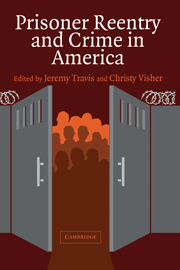Book contents
- Frontmatter
- Contents
- List of Contributors
- 1 INTRODUCTION
- 2 FROM CELL TO SOCIETY
- 3 REENTRY AS A TRANSIENT STATE BETWEEN LIBERTY AND RECOMMITMENT
- 4 THE CONTRIBUTION OF EX-PRISONERS TO CRIME RATES
- 5 DOES SUPERVISION MATTER?
- 6 THE IMPACT OF IMPRISONMENT ON THE DESISTANCE PROCESS
- 7 COMMUNITIES AND REENTRY
- 8 WORK AND FAMILY PERSPECTIVES ON REENTRY
- 9 CONSIDERING THE POLICY IMPLICATIONS
- Index
2 - FROM CELL TO SOCIETY
WHO IS RETURNING HOME?
Published online by Cambridge University Press: 05 June 2012
- Frontmatter
- Contents
- List of Contributors
- 1 INTRODUCTION
- 2 FROM CELL TO SOCIETY
- 3 REENTRY AS A TRANSIENT STATE BETWEEN LIBERTY AND RECOMMITMENT
- 4 THE CONTRIBUTION OF EX-PRISONERS TO CRIME RATES
- 5 DOES SUPERVISION MATTER?
- 6 THE IMPACT OF IMPRISONMENT ON THE DESISTANCE PROCESS
- 7 COMMUNITIES AND REENTRY
- 8 WORK AND FAMILY PERSPECTIVES ON REENTRY
- 9 CONSIDERING THE POLICY IMPLICATIONS
- Index
Summary
It is estimated that about 630,000 people were released from U.S. prisons in 2002, a number equal to the population of Washington, DC, and greater than that of Wyoming (Harrison and Karberg, 2004). Who exactly are the people coming home? What continuing danger do they pose to their families and communities? How have their prison experiences prepared them for reentry? Understanding offenders' crimes and life circumstances is a necessary precursor to designing successful reintegration programs.
But the seemingly simple question, “Who is coming home?” has no easy answer. In fact, respected analysts have given widely differing answers to it. There are those who argue that returning prisoners are mostly first-time and nonviolent offenders. Austin and Irwin (2001) write: “Our research indicates that most people being sent to prison today are very different than the specter of Willie Horton that fuels the public's fear of crime. More than half of the persons sent to prison committed crimes that lacked any of the features the public believes compose a serious crime.” Elsewhere Austin (2001) writes: “A significant number of prison releases will pose little risk to public safety.”
Other analysts reach markedly different conclusions. They argue that the vast majority of those in prison and coming home are dangerous career criminals.
- Type
- Chapter
- Information
- Prisoner Reentry and Crime in America , pp. 15 - 49Publisher: Cambridge University PressPrint publication year: 2005
- 60
- Cited by

